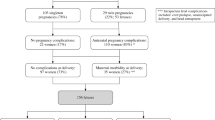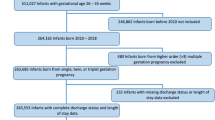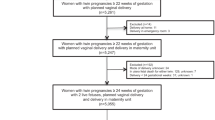Abstract
OBJECTIVE:
To identify the etiology and impact of preterm delivery in twin gestations.
STUDY DESIGN:
Twin gestations delivered at 33.0 to 36.9 weeks were identified in a perinatal database, and categorized by indication for delivery. Deliveries were identified as indicated, or non-indicated (discretionary). Neonatal outcomes were measured by birth weight, length of stay, NICU admission, and ventilator utilization. Data were divided and analyzed by indicated or discretionary delivery, and gestational age at delivery.
RESULTS:
Analyzed were 3252 twin gestations (6504 infants), with 78% having indicated delivery. Of the 22% with discretionary delivery, nearly 40% required NICU admission. With each advancing week of gestation, there was a significant decrease in incidence of NICU admission and nursery days.
CONCLUSION:
The majority of preterm deliveries were indicated, though 22% were discretionary. It is vital to consider neonatal morbidity and costs related to gestational age when choosing discretionary delivery.
Similar content being viewed by others
References
Martin JA, Hamilton BE, Sutton PD, Ventura SJ, Menacker F, Munson ML . Births: Final Data for 2002 National Vital Statistics Reports, Vol.52, No.10. Hyattsville, MD: National Center for Health Statistics; 2003.
Lam F, Bergauer NK, Jacques D, Coleman SK, Stanziano GJ . Clinical and cost-effectiveness of continuous subcutaneous terbutaline versus oral tocolytics for treatment of recurrent preterm labor in twin gestations. J Perinatol 2001;21:444–450.
Gardner MO, Goldenberg RL, Cliver SP, Tucker JM, Nelson KG, Copper RL . The origin and outcome of preterm twin pregnancies. Obstet Gynecol 1995;85:553–557.
Büscher U, Horstkamp B, Wessel J, Chen FCK, Dudenhausen JW . Frequency and significance of preterm delivery in twin pregnancies. Int J Gynaecol Obstet 2000;69:1–7.
Knuppel RA, Lake MF, Watson DL, et al. Preventing preterm birth in twin gestation: home uterine activity monitoring and perinatal nursing support. Obstet Gynecol 1990;76:24S–27S.
Roberts WE, Morrison JC . Has the use of home monitors, fetal fibronectin, and measurement of cervical length helped predict labor and/or prevent preterm delivery in twins? Clin Obstet Gynecol 1998;41:95–102.
Luke B, Bigger HR, Leurgans S, Sietsema D . The cost of prematurity: a case–control study of twins versus singletons. Am J Public Health 1996;86:809–814.
Joseph KS, Allen AC, Dodds L, Vincer MJ, Armson BA . Causes and consequences of recent increases in preterm birth among twins. Obstet Gynecol 2001;98:57–64.
Dyson DC, Crites YM, Ray DA, Armstrong MA . Prevention of preterm birth in high-risk patients: the role of education and provider contact versus home uterine monitoring. Am J Obstet Gynecol 1991;164:756–762.
Hartley RS, Emanuel I, Hitti J . Perinatal mortality and neonatal morbidity rates among twin pairs at different gestational ages: optimal delivery timing at 37 to 38 weeks' gestation. Am J Obstet Gynecol 2001;184:451–458.
Ladden M . The impact of preterm birth on the family and society: Part 1: psychologic sequelae of preterm birth. Pediatr Nurs 1990;16:515–518.
Warner BB, Kiely JL, Donovan EF . Multiple births and outcome. Clin Perinatol 2000;27 (2):347–361.
Kogen MD, Alexander GR, Kotelchuck M, et al. Trends in twin birth outcomes and prenatal care utilization in the United States, 1981–1997. JAMA 2000;283:335–341.
Author information
Authors and Affiliations
Rights and permissions
About this article
Cite this article
Elliott, J., Istwan, N., Collins, A. et al. Indicated and Non-Indicated Preterm Delivery in Twin Gestations: Impact on Neonatal Outcome and Cost. J Perinatol 25, 4–7 (2005). https://doi.org/10.1038/sj.jp.7211205
Published:
Issue Date:
DOI: https://doi.org/10.1038/sj.jp.7211205
- Springer Nature America, Inc.
This article is cited by
-
Changing patterns of fetal lung maturity testing
Journal of Perinatology (2008)
-
Twin Gestation and Premature Birth
Journal of Perinatology (2005)




